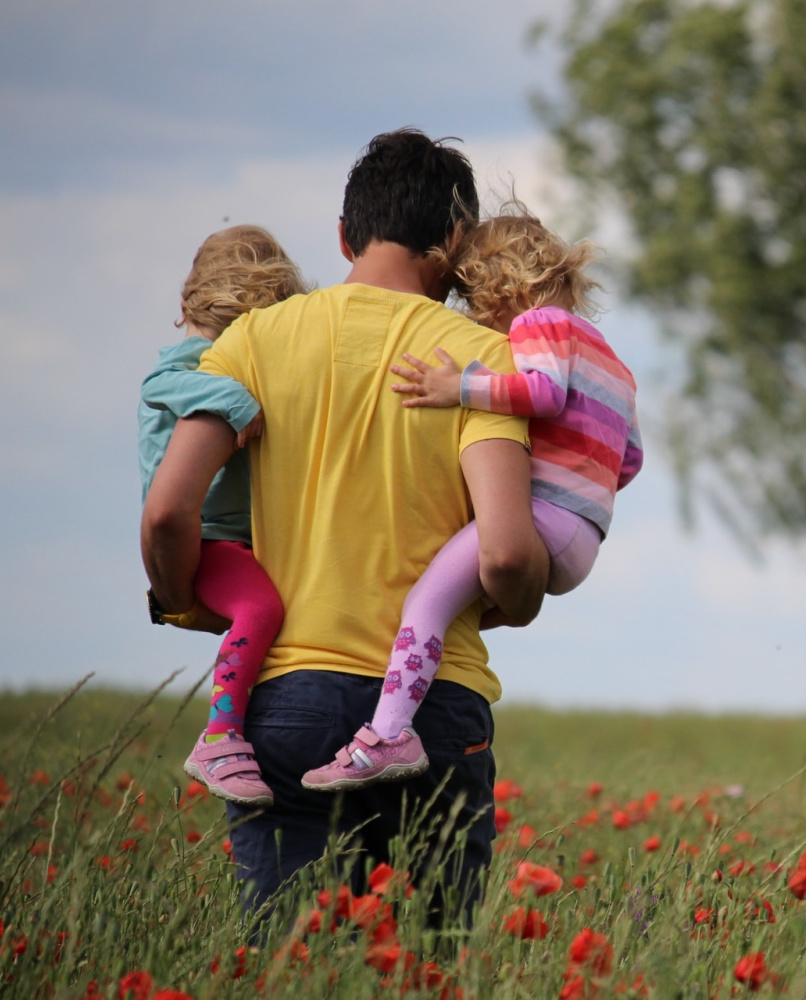Not long ago, my teenage son asked me a surprisingly insightful question: “Why do people talk about modesty for girls more than boys?”
My response was informed by the very frustrating several hours I had just spent at the mall with my tween daughter in the name of back-to-school shopping. I went willing to buy her a few things for the new school year. We both came home frazzled—she because she got almost nothing and I because there was almost nothing I was willing to buy for her.
“Buddy, it’s because what is offered to girls and what is offered to boys is very different,” I told him. I pointed out his outfit—a t-shirt and basketball shorts to his knees, standard issue for a teen boy. But walk into a store or visit a site for girls, and it’s an entirely different story. Our daughters are offered tube tops, thong bikinis, booty shorts, and bralettes—by the time they are 10. Popular cheap shopping sites like Shein and Temu provide provocative images of how to wear their skimpy garb.
Parents like me don’t discuss clothing choices with our daughters more often than our sons because we don’t want people to see our daughters’ belly buttons or bare shoulders. We do because the message to our kids feels obvious: for girls, to be beautiful is to be sexual, and for boys, sexualized girls are beautiful. That’s a message we are trying to intercept before it takes root.
However, clothing is a small but visible thread in a much more pervasive problem: the incessant sexualizing of our children from seemingly all quarters. As the mother of three teens, I have seen my children bombarded at every turn with sexual images, themes, and content. Social media, reels, ads, video games, and straight-up pornography are sitting in their hands, accessible at a click, even with (the sorry excuse for) parental controls locked and loaded. The questions for concerned parents are straightforward: How did we get here, and what do we do now?
The Pervasive Problem
Anymore, sexual imagery is found wherever kids are found. It comes in the form of Snapchat filters that instantly make kids look like porn stars and Snap Chat’s Discover feature, which is stocked with sexual clickbait. Anime is replete with sexualized imagery, particularly of girls, and includes an entire subgenre of animated pornography. The gaming world offers a wide range of sexualized animation and skins, which are often busty, scantily clad women but include plenty of ripped, shirtless men as well. A popular YouTube gamer has a male avatar whose skin is simply a sheath across his chest and women’s panties on his bottom. Popular kids’ gaming site Roblox has ongoing problems with sexual content as well as predators. And if something is benign in its own right, there are no guarantees the ads will be. Ads for adult content pop up all over children’s apps and videos, and algorithms make sure they keep coming back. Clothing is a small but visible thread in a much more pervasive problem.
By the time kids are in their teens, almost 85 percent of boys and almost 60 percent of girls have viewed pornography, most often accessed through mobile devices. Sixteen-year-old Isabel Hogben wrote a sobering essay for The Free Press, explaining just how ubiquitous pornography use is amongst her peers. She gives an adolescent voice to what studies are documenting: children and teens not only see pornography, but they believe pornography.
“[T]he preadolescent and adolescent brain doesn’t know it’s all fake. It believes wholeheartedly what it sees. I certainly did,” she admits. “[M]ost of my friends think this stuff is normal.”
Kids are becoming inured to sexual behavior in general while learning the most aberrant forms of it, believing this to be how typical sexual relationships function.
Youth are also creating their own pornography, as sexting is commonplace for adolescents, who believe sharing nudes in a relationship or even just flirting is normal and expected. Too often, sexting has devastating consequences as teens are extorted or bullied with images of their own making or even with deep fake images created with AI.
If this wasn’t enough, childhood sexuality is being canonized in spaces traditionally considered safe for children. School curricula, children’s literature, children’s programming, and even state legislatures and judiciaries are elevating the messaging that sexuality is somehow key to a healthy childhood.
Nature vs. Nurture
How we arrived at this point is a complex story. In part, our current circumstances are the natural evolution of the sexual revolution that began as far back as the turn of the 20th Century with Sigmund Freud and the Jazz Age, accelerated through the 1960s and 70s, and went off the rails with the advent of the World Wide Web. In more sinister ways, children’s involvement was never a byproduct of sexual liberation but rather the ultimate intent.
In the natural course of things, the dangerous potential of the Internet was suspected at the outset, and anti-pornography organizations pushed Congress in the 1990s to pass the Communications Decency Act of 1996. However, it was immediately challenged by the American Civil Liberties Union (ACLU), and in 1997, the Supreme Court unanimously struck it down in the name of free speech and overreach. Kids are becoming inured to sexual behavior.
Since then, unfettered by legalities, tech companies have had the freedom to drive engagement without the complications of providing protections. Twenty-five years later, apps used by kids every day are perennially among the Dirty Dozen, an annual list compiled by the National Center on Sexual Exploitation (NCOSE) calling out companies that put children at risk of exposure to sexual content or predators. The 2023 dozen included Roblox, Snapchat, Instagram, Discord, and Spotify.
Instagram whistleblower Aurtoro Bejar testified before Congress in November 2023 that parent company Meta willfully fails to protect teens from sexual harassment and unwanted advancements. “All of this time, there has been extensive harm happening to teenagers, and the leadership has been aware of it, but they have chosen not to investigate or address the problems,” Bejar said. “Looked at over time, it is likely the largest-scale sexual harassment of teens to have ever happened.”
As for the “more effective and less restrictive” solution of software filtering, any parent who has tried to set up controls on their children’s devices or apps can attest that if such controls exist at all, they are not designed to be easy to set up or even successful. Companies that create filtering tools are constantly chasing changes made by Apple or Andriod and, therefore, are usually a step (or several) behind their capabilities. Too many parents are overwhelmed by the sheer effort it takes to manage their children’s digital consumption and trust that sites like YouTube Kids have child protection under control. (They don’t.)
Children of the Future

The nurture side of the current problem has a more sinister undercurrent. Freud first posited that child development should be understood in psychosexual stages, including his Oedipal Complex theory. Freud’s star student, Austrian psychoanalyst Wilhelm Reich, coined the term “sexual revolution” with his 1936 treatise of the same title. American researcher Alfred Kinsey earned the title “father of the sexual revolution” through highly controversial studies in the mid-twentieth century that ran the gamut of sexual experiences, including involving children. Others like Norman O. Brown took up the banner, playing a key role in igniting the free love of the 1960s and ‘70s with his own tome on sexuality.
Each of these philosophers shared a common and concerning theme, summarized by Brown: “Our repressed desires are the desires we had, unrepressed, in childhood; and they are sexual desires.” Their common and concerning goal: liberate them. Kinsey believed “sexual contact would be a normal part of growing up for children in a less inhibited society,” and Reich detailed how this liberation should take place in a book to which he gave the chilling title, Children of the Future.
For the most part, societal guardrails have protected children, with sexual behavior involving a child still squarely defined as abhorrent abuse, morally repugnant, and patently illegal. As a society, we still believe, “It were better for him that a millstone were hanged about his neck, and he cast into the sea, than that he should offend one of these little ones” (Luke 17:3).
But these 20th-century sexologists’ views are sneaking into 21st-century spaces for children.
In Germany, a professional association on sexuality issued a recommendation that daycares implement “body exploration rooms” for young children, which would include nudity and “sexual games.” In Denmark, the Netherlands, and the UK, a version of a television show called Naked Education teaches teens about the body and then has a panel of adults disrobe to full nudity in front of them. A professor in the United States garnered attention when she said children should see adult genitalia regularly in a “casual, normalized way.” And there is an effort to move away from the term “pedophile” and toward the term “minor attracted person” (MAP) so as to destigmatize an adult’s sexual attraction to children.
Queer Pedagogy
We cannot have an honest or complete conversation about the sexualization of children without including queer theory and pedagogy. Queer theory, as an academic focus, seeks to “disrupt dominant and normalizing binaries,” citing such norms as oppressive. Queer pedagogy is the practical application of queer theory in classrooms.
This is captured in the 2010 academic article, “Recognizing and Utilizing Queer Pedagogy,” where the authors cite Kinsey as their opening salvo and then explain that the simple fight for acceptance has burgeoned into the “redefinition of sexual identity and sexuality itself.” They explain that “educators are understood to be either upholding the status quo or to be defining/redefining what is classified as ‘normal’ in their classrooms, and thus in the larger society as well.” “Queer and trans pedagogies seek to actively destabilize the normative function of schooling.”
Given that these standards are designed for K-12 curriculums, there is an unsettling air of Reich, Kinsey, and Brown in that statement about all people.
Drag Story Hour is a program for kids offered to schools, libraries, and bookstores in which drag queens read books (usually with queer themes) to groups of children. The program has partnered with PBS, Disney, and Hulu, among others. The program describes itself as “a generative extension of queer pedagogy into the world of early childhood education” and explains that “queer and trans pedagogies seek to actively destabilize the normative function of schooling through transformative education” and “queer imagining in an early childhood context.” (Emphasis added.)
This “queer imagining” is also found in Disney’s “not so secret” gay agenda, the Blue’s Clues pride parade sing-along, Scholastic’s diversity collections, and elementary classroom teachers “reading the rainbow.” An American Library Association’s 2023 recommended reading list for teens includes New Queer Fairy Tales, A Queer Romance Anthology, and A Quick and Easy Guide to Asexuality, just to cite a few titles.
A founder of Drag Story Hour, Lil Miss Hot Mess, summarizes the goal of queer pedagogy: “It artfully invites children into building communities that are more hospitable to queer knowledge and experience.”
In other words, children are the tools for building the future these adults want to create.
“Nothing can replace you.”
It is enough to make a parent feel overwhelmed and outgunned. But there is hope.
Andrew Young was an animator for DreamWorks when he noticed something concerning. The movies he was working on had a strangely anti-family subtext. Lunatic villains spouted off pro-family messaging in deranged rants—casting such messaging as crazy. Young confronted the powers that be at DreamWorks and discovered his observations were not only accurate, but the messaging was intentional—a form of social engineering. Young was appalled, and his journey led him to abandon a lucrative job as the only option his personal integrity would allow.
In sharing his story, Young noted the one hitch in DreamWorks’ plan: “Nothing can replace you. This is the problem [DreamWorks] found. Nothing could replace a stable parent in influence and modeling,” noting that social engineering only takes root in “a void of influence.”
A recent study by Gallup and the Institute for Family Studies supports Young’s observation: “Screen time has no association with an index of mental health problems for teens who demonstrate high levels of self-control and enjoy a strong relationship with parents who supervise them.” (Emphasis added.)
So the hope is us, parents.
“Influence,” “modeling,” “strong relationships,” and “supervision” are powerful tools for parents. It is our imperative to help our children follow the admonition of Paul and seek that which is pure, virtuous, lovely, or of good report (see Philippians 4:8). It is also our imperative to help our children remain tethered to the real world. Much of this perniciousness seeps in through screens. The more our children engage in the actual, tactile world, the less access these forces have to them.
While parental controls and filtering apps can be clunky and not always effective, they are better than nothing at all, and parents should still use them. Apple offers parental controls and content restrictions for its devices, apps such as Snap Chat and Instagram have developed family settings, services such as Bark and Quistidio provide filtering and monitoring, and routers such as Gryphon block material before it enters your home network.
In matters of sexuality, parents must be the first, most often, and most important source of information. Children will learn; parents will decide if they learn from them or from the Internet, or from their friends. Mostly like it will be from all the above. But the Internet and friends will not instill family values.
Parents also need to work collectively. I admit to loving viral videos of parents standing up at school board meetings to challenge policies and curricula they find concerning. In 2022, more than 20,000 concerned parents forced the Utah State Board of Education to abandon a draft gender policy that would have permitted children to share locker rooms and sleeping quarters based on a student’s “asserted” gender identity. Twenty thousand parents are hard to dismiss.
State legislators are now passing laws, such as age-verification laws for pornography purveyors. In an ironic twist, PornHub, the Internet’s largest pornography conglomerate, blocked access to its own site altogether in those states rather than comply. I would call that mission accomplished. The hope is us, parents.
Members of the LGBT+ community are also stepping in. The organization, Gays against Groomers, does not mince its messaging in its chosen title, and with a nod to how difficult it can be to speak out, a recently formed organization calls itself the LGBT Courage Coalition. Both have a blunt message: Stop sexualizing children under the guise of LGBT+.
The reinforcements are welcomed and needed. But in the end, it comes down to us as parents. As our children navigate this dangerous world, we hope they will be able to say, “[T]he words which I had often heard my father speak … sunk deep into my heart,” and “We do not doubt our mothers knew it” (Enos 1:3 and Alma 56:47).

















